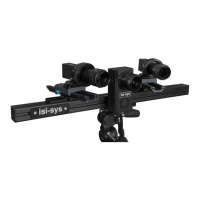CALIBRATION
SELECTING A GRID
To begin, select a grid that approximately fills the field of view.
Too large Correct Too small
If the grid is too large, it will be difficult to keep it fully in the field of view in both cameras while taking images. However,
calibration images will be useful as long as all three of the hollow marker dots are visible. If any of the three marker dots
cannot be seen, then the image cannot be used.
If the grid is too small, it may be difficult for Vic-3D to automatically extract points; additionally, more total images will be
required to cover the field of view, including the corners. However, if no ideally sized grid is available, smaller grids can
work quite well.
Occasionally, lighting configuration can affect grid selection. Some grids may be slightly reflective; under intense or
directional light sources, these reflections can wash out the grid image. For these cases, especially matte grids should be
used, or care taken to avoid reflections.
POSITIONING THE GRID
The calibration procedure calculates variables about the camera geometry and imaging; it is not specific to a plane or
volume in space. Therefore, it’s not necessary to position the calibration grid in the exact same location as the intended
specimen. Still, it will be most convenient to place the grid in roughly the intended plane. This will ensure that the cameras
point at it correctly and that the grid is in good focus.
Optimally, the specimen can be moved and replaced with the grid during the calibration. If this is not practical, it’s often
possible to calibrate directly in front of the specimen; this method does require some extra depth of field because the grid
will be in front of the focal plane rather than directly in it.
If the specimen cannot be moved and there is insufficient depth of field to calibrate in front of the specimen, it may be
necessary to move or rotate the stereo rig for calibration. In this case, it is very important not to disturb the camera
position. The best way to achieve this may be to smoothly rotate the entire mount; this involves a minimum of vibration
and shock compared to dragging the tripod away. Then, calibrate to the left or right of the specimen position before
returning the rig to center.
If the tripod must be moved, it may be helpful to mark the original location of each leg; otherwise, finding the original
rotation and position may be difficult.

